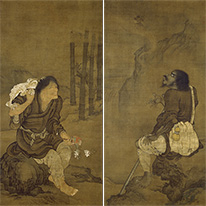Past Exhibitions
- Feature Exhibition: Treasures of Hyakumanben Chion-ji Temple
Part II: The Pure Land / Part III: Gifted Treasures - August 7, 2018 - September 9, 2018
The temple of Chion-ji, located at the Hyakumanben intersection on the east side of Kyoto, is one of the seven major Pure Land (Jōdo Shū) Buddhist temples established by the sect's founding priest Hōnen (1133–1212). The name Chion-ji, "Temple of Wisdom and Blessings," came from its second abbot Genchi (1183–1239). Chion-ji is home to numerous important works of art, including the Chinese masterpiece Liu Haichan and Li Tieguai, by Yuan-dynasty painter Yan Hui, which is an Important Cultural Property of Japan. This exhibition includes findings from the Kyoto National Museum's recent inventory of Chion-ji's collections. Enjoy the artistic treasures of Pure Land Buddhism, a religious tradition with deep roots in Kyoto.
Part II: The Pure Land
The Pure Land teachings of the priest Hōnen (1133–1212) tell us that simply by repeating the nenbutsu (a recitation of the holy name of Amida Buddha), sentient beings can gain salvation and be born into the Pure Land Paradise of Amida (Amitābha in Sanskrit) after death. Chion-ji has numerous painted representations of Amida and the Pure Land, including the Important Cultural Property-designated images Mandala of the Pure Land and Ten Manifestations of Amida (Amitābha) Buddha. It also houses important Pure Land sculptures, including Standing Amida (Amitābha) Buddha, which new scholarship attributes to the Kamakura-period (1185–1333) master Kaikei. Some of the works in the temple were brought to Japan from China or Korea, exemplifying the spread of Pure Land teachings across East Asia.
Part III: Gifted Treasures
From the medieval to early modern periods, Chion-ji was patronized by figures from both the aristocracy and the warrior class. For this reason, it houses not only Buddhist art but also decorative arts and other secular works donated over the centuries by these patrons. Among the portraits housed in Chion-ji are those of Hino Katsumitsu (1429–1476), a Muromachi period courtier whose sister Hino Tomiko was the wife of Shogun Ashikaga Yoshimasa; Shogun Tokugawa Ieyasu (1573–1616); and subsequent generations of Tokugawa shoguns of the Edo period (1615–1868). One of the temple's best known masterworks is the extremely rare pair of Chinese paintings of The Immortals Liu Haichan and Li Tieguai by Yuan-dynasty (1271–1368) master Yan Hui.
Galleries are:
【Gallery 2F-1】Part I: Teachings of the Patriarchs
【Gallery 2F-2】Part II: The Pure Land
【Gallery 2F-3】Part II: The Pure Land
【Gallery 2F-4】Part II: The Pure Land / Part III: Gifted Treasures
【Gallery 2F-5】Part III: Gifted Treasures












